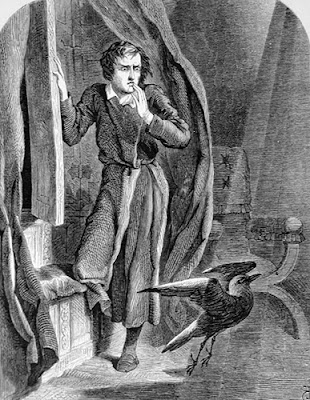 |
| A trade card for Christopher Gibson's upholstery shop in St. Paul's Churchyard, London, 1739-1742. Ink on paper, approx. 6-3/4" x 8-1/4", courtesy of Victoria & Albert Museum. |
Before there were business cards, there were trade cards. At the beginning of the 17th century in London they were used as both advertising and maps, as there wasn't a formal numbering systems for the streets. Since the concept of newspapers at the time was not fully developed, trade cards were the most effective form of advertising. As technology developed that made newspapers more practical and affordable, advertising in them began to be widespread, and trade cards became obsolete.
 |
| Calling card of Johann van Beethoven, Ludwig's brother. Image courtesy of Wikipedia. |
Calling cards, also known as visiting cards, were a descendent of trade cards and they became popular, too; by the Victorian era their use was widespread. These were not only fashionable, but also served as a way to create one's social brand. They were smaller in size than trade cards, usually about 2" x 3". There were fixed rules about using them, as there were about many social conventions of the era.
 |
| King Kelly, catcher for the Boston Beaneaters, 1888. Cards were often included in cigarette packs. Image courtesy of Wikipedia. |
Starting over a hundred years ago both trade and calling cards became collectible items. These were such a favorite pastime for many, that it lead to trading cards, the most developed being baseball cards.
All this history led to a new industry in London, which has spread to other areas where prostitutes ply their trade - Las Vegas comes to mind. Called "tart cards", they are most common in London but are found elsewhere in the United Kingdom. They are typically placed in phone books by professional "carders", who make a run of phone booths replacing cards that are removed by prospective clients, angry citizens, collectors, or the telephone company.
 |
| Image courtesy of Corkscrew-balloon. |
Despite numerous attempts to make them illegal and difficult to place, the use of tart cards perseveres. Ten years ago it was estimated that about 13 million cards were placed in London phone boxes each year. There have been efforts to prosecute anyone leaving cards in phone booths, and to cut the phone lines of the numbers on the cards, but to no avail.
 |
| Image courtesy of Corkscrew-balloon. |
One of the more original ways that has been tried to keep the cards in booths is by use of cards that had adhesive stickers on the back. This made it very difficult for the phone company to remove, as it left a white layer behind that would scratch the booth when scrapers were used. So the phone company came up with an ingenuous chemical anti-adhesive spray, which allowed the cards to be peeled off easily.
 |
| Image courtesy of Corkscrew-balloon. |
However, by this time tart cards became much coveted collectibles, and the sticker ones even more desirable. So they remain until they are taken. Tourists are known to take the standard cards and send them as postcards. They have become part of London folklore; they now have a cult following. Even kids are collecting them.
 |
| Image courtesy of Corkscrew-balloon. |
Wallpaper magazine, in conjunction with St Bride Library and Type, asked graphic designers to tease out the tart within every font and create their own designs for tart cards. These graphic qualities lend themselves to the tart card phenomenon, as you can see below:
Tart cards have influenced even mainstream artists. However, they are not meant to glamorize the lifestyle of sex workers. This industry has serious issues that are not to be glossed over lightly.
Although the world's oldest profession has kept up with the times, using the internet and mobile phones, the use of tart cards endures.
***************
Unless otherwise noted, images from Wallpaper magazine.
If you interested in seeing more of the "graphic art" cards,
be forewarned, some are not for the timid!
Also, please read designer Mike Dempsey's remarks about
the sex industry, also from Wallpaper.
*******************************





































